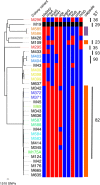Characterization of pre-antibiotic era Klebsiella pneumoniae isolates with respect to antibiotic/disinfectant susceptibility and virulence in Galleria mellonella
- PMID: 25896708
- PMCID: PMC4468732
- DOI: 10.1128/AAC.05009-14
Characterization of pre-antibiotic era Klebsiella pneumoniae isolates with respect to antibiotic/disinfectant susceptibility and virulence in Galleria mellonella
Abstract
The EGD Murray collection consists of approximately 500 clinical bacterial isolates, mainly Enterobacteriaceae, isolated from around the world between 1917 and 1949. A number of these "Murray" isolates have subsequently been identified as Klebsiella pneumoniae. Antimicrobial susceptibility testing of these isolates showed that over 30% were resistant to penicillins due to the presence of diverse blaSHV β-lactamase genes. Analysis of susceptibility to skin antiseptics and triclosan showed that while the Murray isolates displayed a range of MIC/minimal bactericidal concentration (MBC) values, the mean MIC value was lower than that for more modern K. pneumoniae isolates tested. All Murray isolates contained the cation efflux gene cepA, which is involved in disinfectant resistance, but those that were more susceptible to chlorhexidine were found to have a 9- or 18-bp insertion in this gene. Susceptibility to other disinfectants, e.g., H2O2, in the Murray isolates was comparable to that in modern K. pneumoniae isolates. The Murray isolates were also less virulent in Galleria and had a different complement of putative virulence factors than the modern isolates, with the exception of an isolate related to the modern lineage CC23. More of the modern isolates (41% compared to 8%) are classified as good/very good biofilm formers, but there was overlap in the two populations. This study demonstrated that a significant proportion of the Murray Klebsiella isolates were resistant to penicillins before their routine use. This collection of pre-antibiotic era isolates may provide significant insights into adaptation in K. pneumoniae in relation to biocide susceptibility.
Copyright © 2015, American Society for Microbiology. All Rights Reserved.
Figures



References
-
- Giuffrè M, Bonura C, Geraci DM, Saporito L, Catalano R, Di Noto S, Nociforo F, Corsello G, Mammina C. 2013. Successful control of an outbreak of colonization by Klebsiella pneumoniae carbapenemase producing K. pneumoniae sequence type 258 in a neonatal intensive care unit, Italy. J Hosp Infect 85:233–236. doi:10.1016/j.jhin.2013.08.004. - DOI - PubMed
-
- Yigit H, Queenan AM, Anderson GJ, Domenech-Sanchez A, Biddle JW, Steward CD, Alberti S, Bush K, Tenover FC. 2001. Novel carbapenem-hydrolyzing beta-lactamase, KPC-1, from a carbapenem-resistant strain of Klebsiella pneumoniae. Antimicob Agents Chemother 45:1151–1161. doi:10.1128/AAC.45.4.1151-1161.2001. - DOI - PMC - PubMed
Publication types
MeSH terms
Substances
Grants and funding
LinkOut - more resources
Full Text Sources
Medical
Molecular Biology Databases

